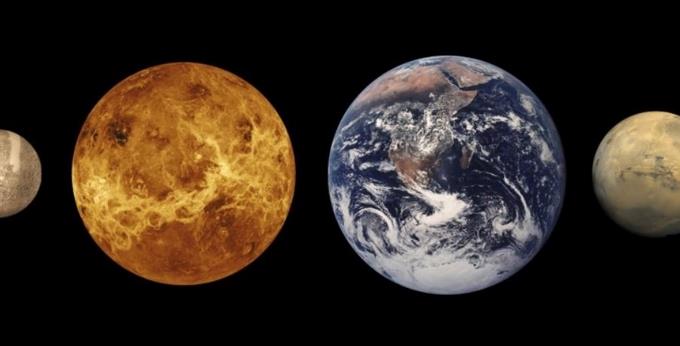Earth and Mars formed from objects that appeared inside the Solar System; Only a small percentage formed beyond Jupiter’s orbit.
A team of researchers led by the University of Munster (Germany) reports these findings in the journal Science Advances. They make a very detailed comparison with the date of the isotopic composition of the oldest building materials of the Earth, Mars and the inner and outer solar system.
Some of these materials are still largely unchanged in meteorites today. The results of the study have far-reaching implications for our understanding of the process by which the planets Mercury, Venus, Earth and Mars were formed. According to the authors, the theory that the four rocky planets grew to their current size by accumulating millimeters of dust pebbles is unacceptable.
About 4.6 billion years ago, in the early days of our solar system, a disk of dust and gases orbited the young Sun. Two theories describe how rocky planets formed from this original building material over millions of years.
According to ancient theory, the dust in the inner solar system accumulated into larger and larger particles and gradually grew to the size of our moon.
The collisions of these planetary nuclei eventually formed the inner planets Mercury, Venus, Earth and Mars. However, a new theory prefers a different growth process: millimeter-sized “pebbles” migrated from the outer solar system of dust toward the sun. Along the way, they accumulated in the planetary nuclei of the inner solar system and gradually expanded to their current size.
Both theories are based on theoretical models and computer simulations designed to reconstruct the conditions and dynamics of the early solar system; Both describe the possible planetary formation path. But which is right? What process really happened?
To answer these questions in their current study, the new study team determined the exact combination of Earth and Mars. “We wanted to find out if the building blocks of Earth and Mars appeared in the outer or inner solar system,” said Dr. Christoph Burkard, the first author of the study at the University of Munster.
For this purpose, the isotopes of the rare metals titanium, zirconium and molybdenum, which are found in small traces in the silicate outer layers of the two planets, provide important clues. Isotopes are different types of the same element, differing only in their atomic weight.
Scientists believe that these and other metal isotopes were not evenly distributed in the early solar system. On the contrary, its abundance depends on the distance from the sun. Therefore, they contain valuable information about where the body building blocks, given in the early solar system, came from.
In particular, the researchers used two types of meteorites, one for the original isotopic cargo of the outer and inner solar system. These rock particles usually came to Earth from the asteroid belt between the orbits of Mars and Jupiter. They are often considered antiques from the early solar system.
Carbonaceous chondrites, which contain a small percentage of carbon, appeared beyond Jupiter’s orbit and only then moved to the asteroid belt due to the influence of increasing gas giants. , Non-carbonaceous chondrites are true children of the inner solar system.
The exact isotopic composition of Earth’s accessible outer rock layers and two types of meteorites has been studied for some time; However, there is no complete comparative analysis of the rocks of Mars. In their current study, the researchers studied samples of a total of 17 Martian meteorites, which can be assigned to six types of Mars rocks. In addition, the scientists studied for the first time an abundance of three different metal isotopes.
Meteorite samples from Mars were first pulverized and subjected to complex chemical pre-treatment. Using a multicollector plasma mass spectrometer at the Institute of Planetology at the University of Munster, researchers were able to detect small-scale titanium, zirconium and molybdenum isotopes. They operated computer simulations to calculate the rate at which construction materials found today on carbonaceous and non-carbonaceous chondrates must be attached to Earth and Mars to recreate their measured compounds.
In doing so, they considered two different phases of development to explain the different histories of the isotopes titanium and zirconium and the isotopes of molybdenum. Unlike titanium and zirconium, molybdenum concentrates primarily at the metal planet center.
Therefore, the small amounts still found today in the silicate-rich outer layers may have been included only in the last stages of the planet’s development.
The researchers’ results show that the outer rock layers of Earth and Mars are somewhat similar to the carbonaceous chondrites of the outer solar system. They make up only four percent of the original building blocks for both planets.
According to Dr. Thorsten Klein, a professor at the University of Munster and director of the Max Planck Institute, “If early Earth and Mars had accumulated dust mainly from the outer solar system, this value would have been almost ten times higher. For solar system research in Kottingen.” Can’t confirm, “he added.
But the composition of Earth and Mars does not exactly match the meaning of non-carbonaceous chondrites. Computer simulations suggest that other types of construction materials must have been played as well.
“This third type of building material, which is inferred by our computer simulations, is an isotopic compound that must have appeared inside the solar system,” explains Christoph Burkard. Since bodies closest to the Sun are never scattered in the asteroid belt, this material is almost completely absorbed by the inner planets and is not found in meteorites. “It simply came to our notice then that this was a ‘lost building material’,” said Thorsten Klein.
The surprising finding does not change the results of the study for planetary formation theory. “Earth and Mars are mostly composed of inner solar system objects that fit in well with the formation of planets from collisions with larger bodies in the inner solar system,” concludes Christoph Burkard.





:quality(85)/cloudfront-us-east-1.images.arcpublishing.com/infobae/KTKFKR763RBZ5BDQZJ36S5QUHM.jpg)